Five sense 教授感官动词
- 格式:ppt
- 大小:12.84 MB
- 文档页数:16
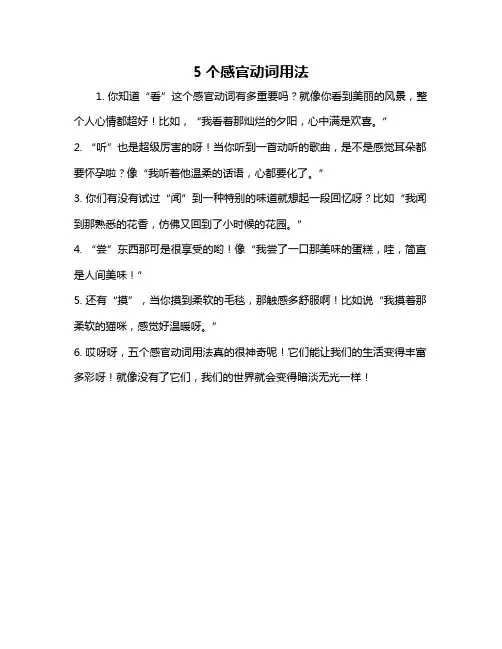
5个感官动词用法
1. 你知道“看”这个感官动词有多重要吗?就像你看到美丽的风景,整个人心情都超好!比如,“我看着那灿烂的夕阳,心中满是欢喜。
”
2. “听”也是超级厉害的呀!当你听到一首动听的歌曲,是不是感觉耳朵都要怀孕啦?像“我听着他温柔的话语,心都要化了。
”
3. 你们有没有试过“闻”到一种特别的味道就想起一段回忆呀?比如“我闻到那熟悉的花香,仿佛又回到了小时候的花园。
”
4. “尝”东西那可是很享受的哟!像“我尝了一口那美味的蛋糕,哇,简直是人间美味!”
5. 还有“摸”,当你摸到柔软的毛毯,那触感多舒服啊!比如说“我摸着那柔软的猫咪,感觉好温暖呀。
”
6. 哎呀呀,五个感官动词用法真的很神奇呢!它们能让我们的生活变得丰富多彩呀!就像没有了它们,我们的世界就会变得暗淡无光一样!。
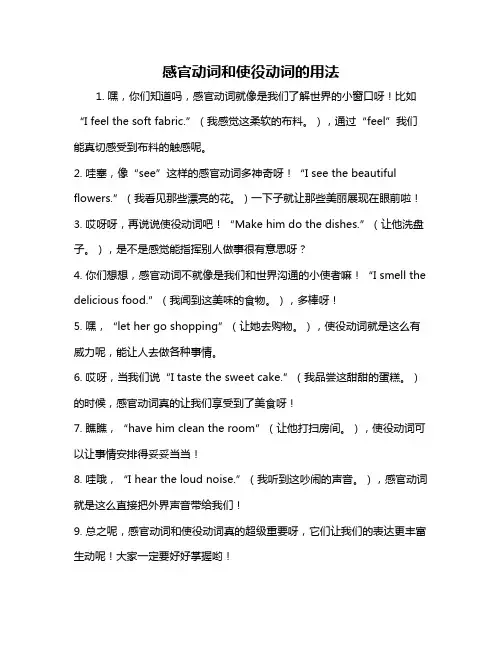
感官动词和使役动词的用法
1. 嘿,你们知道吗,感官动词就像是我们了解世界的小窗口呀!比如“I feel the soft fabric.”(我感觉这柔软的布料。
),通过“feel”我们能真切感受到布料的触感呢。
2. 哇塞,像“see”这样的感官动词多神奇呀!“I see the beautiful flowers.”(我看见那些漂亮的花。
)一下子就让那些美丽展现在眼前啦!
3. 哎呀呀,再说说使役动词吧!“Make him do the dishes.”(让他洗盘子。
),是不是感觉能指挥别人做事很有意思呀?
4. 你们想想,感官动词不就像是我们和世界沟通的小使者嘛!“I smell the delicious food.”(我闻到这美味的食物。
),多棒呀!
5. 嘿,“let her go shopping”(让她去购物。
),使役动词就是这么有威力呢,能让人去做各种事情。
6. 哎呀,当我们说“I taste the sweet cake.”(我品尝这甜甜的蛋糕。
)的时候,感官动词真的让我们享受到了美食呀!
7. 瞧瞧,“have him clean the room”(让他打扫房间。
),使役动词可以让事情安排得妥妥当当!
8. 哇哦,“I hear the loud noise.”(我听到这吵闹的声音。
),感官动词就是这么直接把外界声音带给我们!
9. 总之呢,感官动词和使役动词真的超级重要呀,它们让我们的表达更丰富生动呢!大家一定要好好掌握哟!。
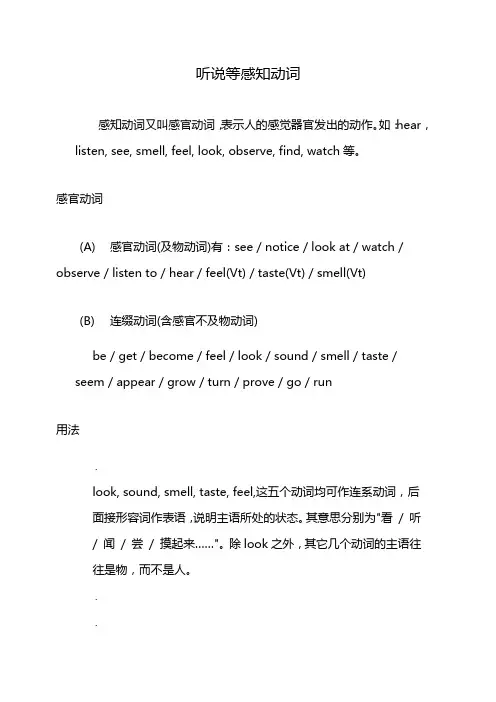
听说等感知动词感知动词又叫感官动词,表示人的感觉器官发出的动作。
如:hear,listen, see, smell, feel, look, observe, find, watch等。
感官动词(A)感官动词(及物动词)有:see / notice / look at / watch / observe / listen to / hear / feel(Vt) / taste(Vt) / smell(Vt)(B)连缀动词(含感官不及物动词)be / get / become / feel / look / sound / smell / taste / seem / appear / grow / turn / prove / go / run用法.look, sound, smell, taste, feel,这五个动词均可作连系动词,后面接形容词作表语,说明主语所处的状态。
其意思分别为"看/ 听/ 闻/ 尝/ 摸起来……"。
除look之外,其它几个动词的主语往往是物,而不是人。
..这些动词后面也可接介词like短语句"结构,意为"看起来/ 听起来/ 感觉好像……"。
..感官动词+do 与+doing的区别:感官动词see, watch,observe, notice, look at, hear, listen to, smell, taste, feel +do 表示动作的完整性,真实性;+doing 表示动作的连续性,进行性。
.典型例题1)They knew her very well. They had seen her ___ up from childhood.A. growB. grewC. was growingD. to grow答案:【A】句子意思:他们看着她从小孩子到长大成人。
【因此本句感官动词seen强调的是小孩成长的整个过程,因此用see sb do 的句型。
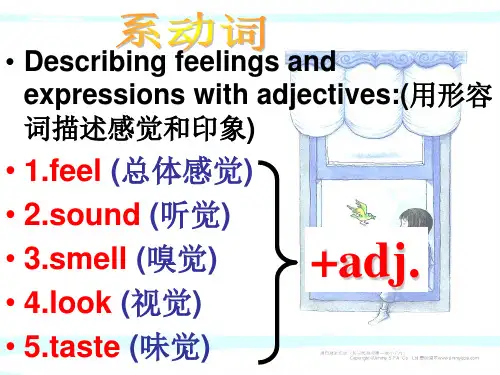

感官动词一、look, sound, smell, taste, feel,这五个动词均可作连系动词,后面接形容词作表语,说明主语所处的状态。
其意思分别为"看/听/闻/尝/摸起来……"。
除look之外,其它几个动词的主语往往是物,而不是人。
例如:These flowers smell very sweet.这些花闻起来很香。
The tomatoes feel very soft.这些西红柿摸起来很软。
二、这些动词后面也可接介词like短语,like后面常用名词。
例如:Her idea sounds like fun.她的主意听起来很有趣。
三、这五个感官动词也可作实义动词,除look(当"看起来……"讲时)只能作不及物动词外,其余四个既可作及物动词也可作不及物动词,此时作为实义动词讲时其主语一般为人。
(和1有区别)例如:She smelt the meat.她闻了闻那块肉。
I felt in my pocket for cigarettes.我用手在口袋里摸香烟。
四、taste, smell作不及物动词时,可用于"taste / smell + of +名词"结构,意为"有味道/气味"。
例如: The air in the room smells of earth.房间里的空气有股泥土味。
五、它们(sound除外)可以直接作名词,与have或take构成短语。
例如:May I have a taste of the mooncakes?我可以尝一口这月饼吗?taste有品位,味道的意思例:I don't like the taste of the garlic. 我不喜欢大蒜的味道。
She dresses in poor taste.她穿着没有品位。
look有外观,特色的意思例:The place has a European look.此地具有欧洲特色。
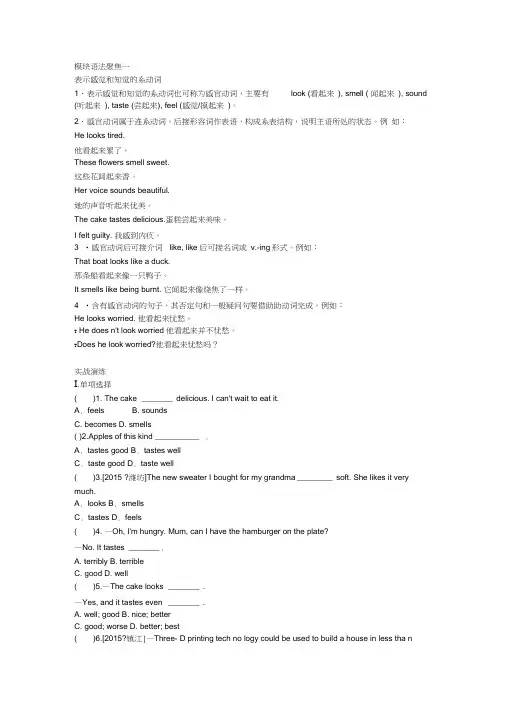
模块语法聚焦一表示感觉和知觉的系动词1.表示感觉和知觉的系动词也可称为感官动词,主要有look (看起来), smell ( 闻起来), sound (听起来), taste (尝起来), feel (感觉/摸起来)。
2.感官动词属于连系动词,后接形容词作表语,构成系表结构,说明主语所处的状态。
例如:He looks tired.他看起来累了。
These flowers smell sweet.这些花闻起来香。
Her voice sounds beautiful.她的声音听起来优美。
The cake tastes delicious.蛋糕尝起来美味。
I felt guilty. 我感到内疚。
3 •感官动词后可接介词like, like后可接名词或v.-ing形式。
例如:That boat looks like a duck.那条船看起来像一只鸭子。
It smells like being burnt. 它闻起来像烧焦了一样。
4 •含有感官动词的句子,其否定句和一般疑问句要借助助动词完成。
例如:He looks worried. 他看起来忧愁。
T He does n't look worried 他看起来并不忧愁。
T Does he look worried?他看起来忧愁吗?实战演练I.单项选择( )1. The cake _______ delicious. I can't wait to eat it.A. feelsB. soundsC. becomesD. smells( )2.Apples of this kind __________ .A. tastes goodB. tastes wellC. taste goodD. taste well( )3.[2015 ?潍坊]The new sweater I bought for my grandma ________ soft. She likes it very much.A. looksB. smellsC. tastesD. feels( )4. —Oh, I'm hungry. Mum, can I have the hamburger on the plate?—No. It tastes _______ .A. terriblyB. terribleC. goodD. well( )5.—The cake looks _______ .—Yes, and it tastes even _______ .A. well; goodB. nice; betterC. good; worseD. better; best( )6.[2015?镇江]—Three- D printing tech no logy could be used to build a house in less tha n24 hours.—It ______ amazing. It's my first time to get to know the news.A.looks B.smells C.sounds D.tastes( )7.Oh, it ___________so nice. What beautiful music it is!A.smells B.soundsC.tastes D.looks( )8.—Dinner is ready. Help yourself!—Wow! It ______ delicious. You are really good at cooking.A.looks B.soundsC.tastes D.feels( )9.—Let's go on a picnic this weekend, OK?—That sounds ______.A.great B.wellC.hardly D.terribly( )10.I like to read English in the garden because the flowers in it smell _______ .A.good B.wellC.bad D.badly( )11. —Do you like swimming in winter?—Of course. The water ______ a bit cold at first, but then I am warm and full of energy. A.tastes B.feels C.smells D.looks( )12.Mum is making dinner. It ___________ so nice!A.smells B.tastesC.feels D.sounds( )13.Good medicine for health __________ bitter to the mouth.A.feel B.tastes C.feels D.taste( )14.Some of my friends eat with their eyes. They prefer to order what _______ nice.A.feels B.smells C.looks D.tastes( )15. —Do you know the song Gangnam Style?—Of course. It ______ interesting.A.tastes B.smells C.sounds D.feelsn .根据汉语意思完成句子1.我的毛衣摸起来柔软。
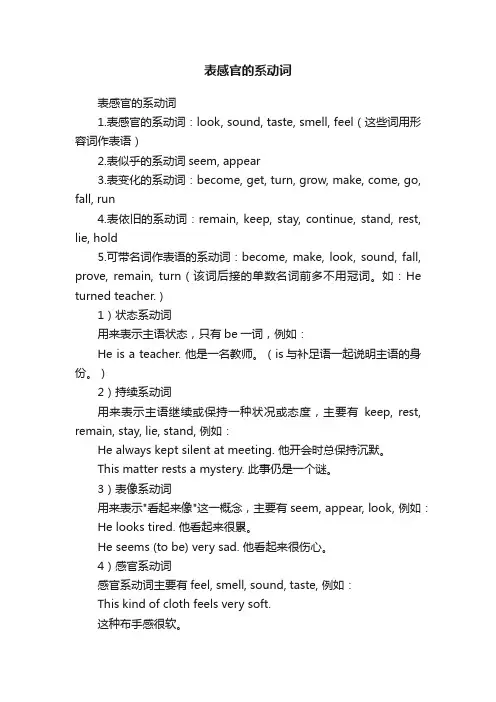
表感官的系动词表感官的系动词1.表感官的系动词:look, sound, taste, smell, feel(这些词用形容词作表语)2.表似乎的系动词seem, appear3.表变化的系动词:become, get, turn, grow, make, come, go, fall, run4.表依旧的系动词:remain, keep, stay, continue, stand, rest, lie, hold5.可带名词作表语的系动词:become, make, look, sound, fall, prove, remain, turn(该词后接的单数名词前多不用冠词。
如:He turned teacher.)1)状态系动词用来表示主语状态,只有be一词,例如:He is a teacher. 他是一名教师。
(is与补足语一起说明主语的身份。
)2)持续系动词用来表示主语继续或保持一种状况或态度,主要有keep, rest, remain, stay, lie, stand, 例如:He always kept silent at meeting. 他开会时总保持沉默。
This matter rests a mystery. 此事仍是一个谜。
3)表像系动词用来表示"看起来像"这一概念,主要有seem, appear, look, 例如:He looks tired. 他看起来很累。
He seems (to be) very sad. 他看起来很伤心。
4)感官系动词感官系动词主要有feel, smell, sound, taste, 例如:This kind of cloth feels very soft.这种布手感很软。
This flower smells very sweet.这朵花闻起来很香。
5)变化系动词这些系动词表示主语变成什么样,变化系动词主要有become, grow, turn, fall, get, go, come, run.例如:He became mad after that. 自那之后,他疯了。
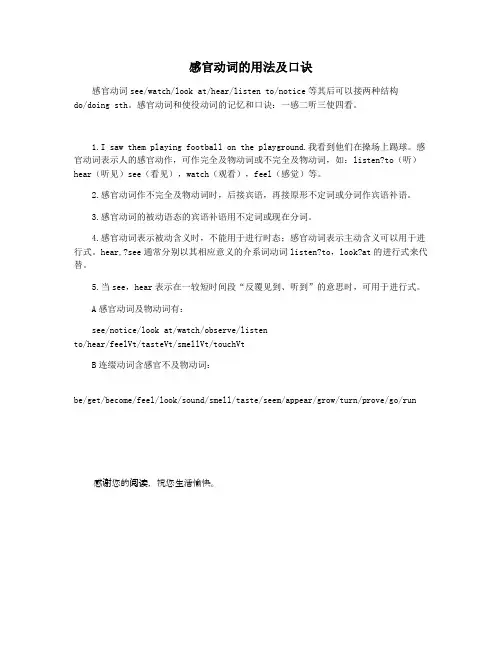
感官动词的用法及口诀
感官动词see/watch/look at/hear/listen to/notice等其后可以接两种结构
do/doing sth。
感官动词和使役动词的记忆和口诀:一感二听三使四看。
1.I saw them playing football on the playground.我看到他们在操场上踢球。
感官动词表示人的感官动作,可作完全及物动词或不完全及物动词,如:listen?to(听)hear(听见)see(看见),watch(观看),feel(感觉)等。
2.感官动词作不完全及物动词时,后接宾语,再接原形不定词或分词作宾语补语。
3.感官动词的被动语态的宾语补语用不定词或现在分词。
4.感官动词表示被动含义时,不能用于进行时态;感官动词表示主动含义可以用于进行式。
hear,?see通常分别以其相应意义的介系词动词listen?to,look?at的进行式来代替。
5.当see,hear表示在一较短时间段“反覆见到、听到”的意思时,可用于进行式。
A感官动词及物动词有:
see/notice/look at/watch/observe/listen
to/hear/feelVt/tasteVt/smellVt/touchVt
B连缀动词含感官不及物动词:
be/get/become/feel/look/sound/smell/taste/seem/appear/grow/turn/prove/go/run 感谢您的阅读,祝您生活愉快。
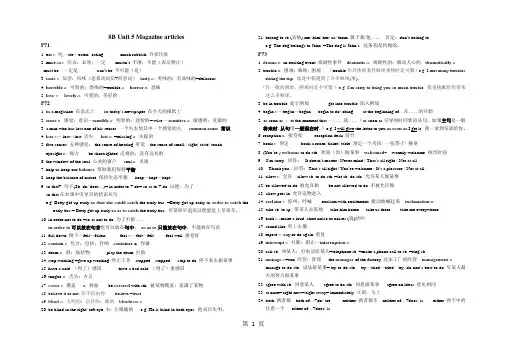
8B Unit 5 Magazine articlesP711. eat v.吃–ate—eaten--eating much rubbish 许多垃圾2. must aux.应该;必须;一定mustn’t 不准;不能(表示禁止)must be 一定是can’t be 不可能(是)3. taste v. 品尝;风味(连系动词后+形容词)--tasty a.美味的;有品味的=delicious4. horrible a.可怕的;恐怖的=terrible a.---horror n. 恐怖5. love v. ---lovely a.可爱的;美好的P721. in a magazine 在杂志上in today’s newspaper 在今天的报纸上2. sense n.感觉;意识—sensible a.明智的;理智的= wise —sensitive a.敏感的;灵敏的3. a man who has lost one of his senses 一个失去他其中一个感觉的人common sense 常识4. lose v.—lost—lost 丢失lost a. =missing a.失踪的5. five senses 五种感觉: the sense of hearing 听觉the sense of smell / sight/ taste/ toucheyesight n.视力be shortsighted 近视的;没有远见的6. the window of the soul 心灵的窗户soul n. 灵魂7. help us keep our balance 帮助我们保持平衡8. keep the balance of nature 保持生态平衡keep—kept—kept9. so that+ 句子(Sb. do/ does…)= in order to + do= so as to + do 以便;为了so that在本课中引导目的状语从句e.g. Betty got up early so that she could catch the early bus. =Betty got up early in order to catch theearly bus.= Betty got up early so as to catch the early bus. 贝蒂很早起床以便能赶上早班车。
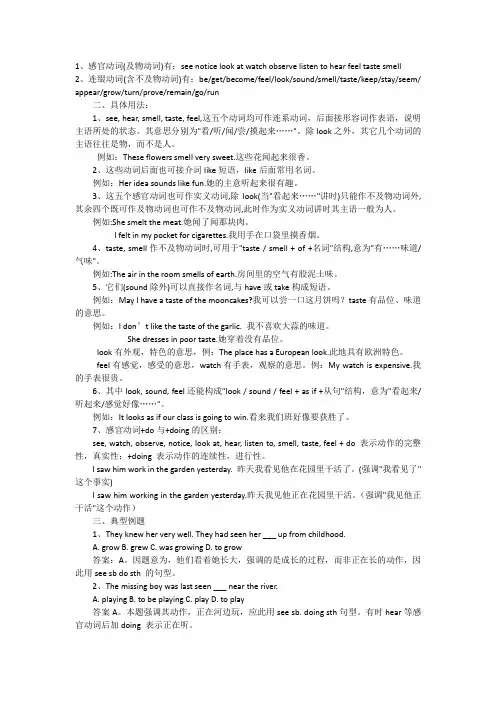
1、感官动词(及物动词)有:see notice look at watch observe listen to hear feel taste smell2、连缀动词(含不及物动词)有:be/get/become/feel/look/sound/smell/taste/keep/stay/seem/ appear/grow/turn/prove/remain/go/run二、具体用法:1、see, hear, smell, taste, feel,这五个动词均可作连系动词,后面接形容词作表语,说明主语所处的状态。
其意思分别为"看/听/闻/尝/摸起来……"。
除look之外,其它几个动词的主语往往是物,而不是人。
例如:These flowers smell very sweet.这些花闻起来很香。
2、这些动词后面也可接介词like短语,like后面常用名词。
例如:Her idea sounds like fun.她的主意听起来很有趣。
3、这五个感官动词也可作实义动词,除look(当"看起来……"讲时)只能作不及物动词外,其余四个既可作及物动词也可作不及物动词,此时作为实义动词讲时其主语一般为人。
例如:She smelt the meat.她闻了闻那块肉。
I felt in my pocket for cigarettes.我用手在口袋里摸香烟。
4、taste, smell作不及物动词时,可用于"taste / smell + of +名词"结构,意为"有……味道/气味"。
例如:The air in the room smells of earth.房间里的空气有股泥土味。
5、它们(sound除外)可以直接作名词,与have或take构成短语。
例如:May I have a taste of the mooncakes?我可以尝一口这月饼吗?taste有品位、味道的意思。
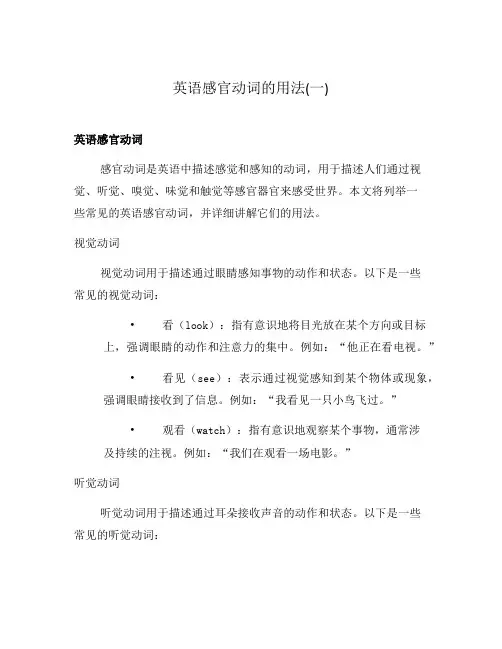
英语感官动词的用法(一)英语感官动词感官动词是英语中描述感觉和感知的动词,用于描述人们通过视觉、听觉、嗅觉、味觉和触觉等感官器官来感受世界。
本文将列举一些常见的英语感官动词,并详细讲解它们的用法。
视觉动词视觉动词用于描述通过眼睛感知事物的动作和状态。
以下是一些常见的视觉动词:•看(look):指有意识地将目光放在某个方向或目标上,强调眼睛的动作和注意力的集中。
例如:“他正在看电视。
”•看见(see):表示通过视觉感知到某个物体或现象,强调眼睛接收到了信息。
例如:“我看见一只小鸟飞过。
”•观看(watch):指有意识地观察某个事物,通常涉及持续的注视。
例如:“我们在观看一场电影。
”听觉动词听觉动词用于描述通过耳朵接收声音的动作和状态。
以下是一些常见的听觉动词:•听(listen):指有意识地接收声音,通常涉及专注和用心倾听。
例如:“他正在听音乐。
”•听到(hear):表示通过听觉感知到声音,强调耳朵接收到了信息。
例如:“我听到有人敲门。
”•倾听(attend):指专心地听某人讲话或某个声音,通常涉及配合眼神或姿势表达出对信息的注意。
例如:“她倾听着老师的讲解。
”嗅觉动词嗅觉动词用于描述通过鼻子嗅到气味的动作和状态。
以下是一些常见的嗅觉动词:•闻(smell):指有意识地嗅到气味,强调鼻子接收到了信息。
例如:“我闻到了鲜花的香味。
”•嗅到(detect):表示通过嗅觉感知到某种气味,强调鼻子接收到了信息。
例如:“狗的嗅觉比人敏锐,可以嗅到地底下的气味。
”•嗅觉敏锐(have a keen sense of smell):表示某人嗅觉灵敏,能够辨别出不同的气味。
例如:“猎犬具有嗅觉敏锐的特点。
”味觉动词味觉动词用于描述通过舌头尝到味道的动作和状态。
以下是一些常见的味觉动词:•尝(taste):指有意识地品尝食物或液体,强调舌头接收到了味道的信息。
例如:“他尝了一口咖啡。
”•感到苦(taste bitter):表示尝到苦味,强调味觉感受。
英语感官动词的记忆方法特点有哪些5个感官动词,当这几个词用作连系动词的时候,它们的意思分别是“看起来”、“听起来”、“闻起来”、“尝起来”、“摸起来”,下面就是小编给大家带来的英语感官动词的记忆方法特点,希望大家喜欢!英语感官动词的记忆方法特点特点一通常以被感觉的东西作主语,虽有被动词味,但不用被动语态。
如:误:The material is felt nice. 这料子摸起来不错。
(is felt 应改为feels)误:The soup is tasted delicious. 这汤味道不错。
(is tasted应改为tastes)特点二其后均可接介词 like。
如:This looks (tastes, smells, feels) like an orange. 这东西看起来(吃起来,闻起来,摸起来)像桔子。
另外,taste和smell后还可接介词of,表示“有…的味道”:It tastes [smells] of fish. 这东西有鱼的味道。
特点三除look外均不用于进行时态(即使是look用于进行时态也不多见)。
如:You look [are looking] tired this evening. 今晚你好像很累。
但是不说What you says is sounding reasonable.【注】feel 表示“感觉”可用于进行时:How are you feeling now? 你现在感觉如何?I’m feeling terrible. 我感到难受极了。
另外,若以上动词用作实意动词,则可以用于进行时态:He is tasting the pudding. 他在尝布丁。
特点四除look外,均不能接 to be(即使是look后接to be也不多见)。
如:She looks (to be) the best person for this job. 她似乎是做这项工作的最佳人选。
感官类系动词知识呈现尝起来很美味!看起来很漂亮!这些极其日常的说法该如何用英语表达呢?此份材料整理了 5 个感官类系动词,帮助孩子轻松 get 感官动词的表述!
感官动词感官动词:用来表示“……起来"这样的概念。feel 感觉起来,摸起来……look 看起来……sound 听起来……smell 闻起来……taste 尝起来…… 例句:He looks tired. 他看上去很疲惫。 Tom feels terrible. 汤姆感觉非常不舒服。单项选择1
练习
( )1. Some of my friends eat with their eyes. They prefer to order what ________ nice. A. feels B. smells C. looks( )2. - How do you feel today? - I ________ sad. A. look B. feels C. feel( )3. The pizza _____ really good. I can't wait to eat it! A. sounds B. smells C. feels( )4.When I see trees and flowers, I ______ happy. A. sound B. feel C. is( )5. The apples in the shop ______ so good. A. isB. smellC. sound( )6. When I meet my friend, I _____ happy.A. soundB. feelC. taste( )7. The glass of juice_______ sweet.A. looksB. sounds C. tastes( )8. The song _______ very nice. Do you know who is the singer?A. smellsB. listens toC. sounds( )9. –How about the cookies?–They_______ great! I cannot stop eating.A. tasteB. isC. sounds( )10. That book _____ really interesting.A. looksB. soundC. read连线2
九年级英语Unit 6知识点与语法精讲精练词汇梳理(一)完成单词梳理:名词:1. heel鞋跟;足跟 2. spoon 勺;铲子 3. electricity 电;电能4. style 样式;款式5. hero 英雄;男主角6. pleasure 高兴;愉快7. zipper 拉链;拉锁8. website 网站9. pioneer 先锋;先驱10. ruler 统治者;支配者11. popularity 受欢迎;普及12. fridge 冰箱13. earthquake 地震14. bell 钟(声)15. biscuit 饼干16. cookie 曲奇饼17. instrument 器械;仪器;工具18. customer 顾客;客户19. basket 篮;筐20. project 项目;工程动词:1. mention 提到;说到 2. boil 煮沸;烧开 3. remain 保持不变;剩余4. translate 翻译5. ring (使)发出钟声或铃声;打6. divide 分开;分散副词:1. nearly 几乎形容词:1. daily 每日的;日常的 2. accidental 意外的;偶然的3. low 低的;矮的4. national 国家的;民族的5. sudden 突然(的)6. musical 音乐的;有音乐天赋的7. crispy 脆的;酥脆的8. salty 咸的9. sour 酸的;有酸味的10. professional 职业的;专业的兼类词:1. list (v)列表;列清单(n)名单;清单2. smell (n)气味(v)发出……气味;闻到3. trade (n)贸易;交易(v)做买卖;从事贸易4. doubt (n)疑惑;疑问(v)怀疑5. somebody (pron)某人(n)重要人物6. lock (v)锁上;锁住(n)锁7. Canadian (adj)加拿大的;加拿大人的(n)加拿大人(二) 词汇变形小结:1. pleasure (n. 高兴;愉快) — please (v. 使满意) — pleased (adj. 高兴的;满意的) — pleasing (adj. 令人高兴的) — pleasant (adj. 令人愉快的)2. accidental(adj. 意外的;偶然的) — accident (n. 意外;事故)3. ruler (n. 统治者) — rule (v. 统治)4. smell (v. 闻到) — smelt/smelled (过去式/过去分词)5. national (adj. 国家的;民族的)— nation (n. 民族)6. trade (v. 做买卖) — trader (n. 商人)7. popularity(n. 受欢迎;普及) — popular (adj. 受欢迎的)8.translate (v. 翻译) — translation (n. 翻译) — translator (n. 翻译家)9. ring (v. 打) — rang (过去式) — rung (过去分词)10. sudden(adj. 突然的) — suddenly (adv. 突然地)11. musical(adj. 音乐的)— music (n. 音乐) — musician (n. 音乐家)12. salty(adj. 咸的)— salt (n. 盐)13. Canadian(adj. 加拿大的)— Canada (n. 加拿大)14. hero(n. 英雄)— heroes (复数)15. daily(adj. 每天的)— day (n. 天;日)16. invent(v. 发明)— invention (n. 发明物) — inventor (n. 发明家)【练一练】用所给词的适当形式填空1.Zheng Chenggong is a great ___national___ (nation) hero in Chinese history.2.They ___rang____ (ring) the bell and came into the room.3.__Suddenly___ (sudden), the candle was blew out by the wind.4.Reading a lot of books brings me a lot of __pleasure__(please).5.puter plays an important role in our ___daily____ (day) life.6.Our new English teacher es from a small __Canadian__(Canada) town.7.There are a lot of ___heroes___(hero) in Chinese history.8.Tea, the most popular drink is an __accidental__(accident) invention.9.The ___ruler____ (rule) of the island was a strict and powerful man.10.My mother likes ___salty___(salt) food, but my father doesn’t like it because he thinks it is unhealthy.(三) 短语攻关:have a point 有道理by accident 偶然;意外地take place 发生;出现without doubt 毫无疑问;的确all of a sudden 突然;猛地by mistake 错误地;无意中divide... into... 把……分开look up to 钦佩;仰慕not only...but also...不但……而且……fall into 落入;陷入lead to 导致translate...into... 把……译成……at the same time 同时with pleasure 乐意效劳the number of ……的数量 e up with 想出;提出encourage sb to do sth鼓励某人做某事achieve one’s dream 实现某人的梦想知识点梳理1.With pleasure! 乐意效劳!【易混辨析】 易错点:it’s a pleasure, my pleasure与with pleasureIt’s a pleasure意为“不客气”,对别人的感谢的礼貌回答My pleasureWith pleasure意为“乐意效劳”,表示客气地接受或同意Eg.►—Thank you very much! 多谢!—It’s a pleasure./My pleasure. 不客气。
矿产资源开发利用方案编写内容要求及审查大纲
矿产资源开发利用方案编写内容要求及《矿产资源开发利用方案》审查大纲一、概述
㈠矿区位置、隶属关系和企业性质。
如为改扩建矿山, 应说明矿山现状、
特点及存在的主要问题。
㈡编制依据
(1简述项目前期工作进展情况及与有关方面对项目的意向性协议情况。
(2 列出开发利用方案编制所依据的主要基础性资料的名称。
如经储量管理部门认定的矿区地质勘探报告、选矿试验报告、加工利用试验报告、工程地质初评资料、矿区水文资料和供水资料等。
对改、扩建矿山应有生产实际资料, 如矿山总平面现状图、矿床开拓系统图、采场现状图和主要采选设备清单等。
二、矿产品需求现状和预测
㈠该矿产在国内需求情况和市场供应情况
1、矿产品现状及加工利用趋向。
2、国内近、远期的需求量及主要销向预测。
㈡产品价格分析
1、国内矿产品价格现状。
2、矿产品价格稳定性及变化趋势。
三、矿产资源概况
㈠矿区总体概况
1、矿区总体规划情况。
2、矿区矿产资源概况。
3、该设计与矿区总体开发的关系。
㈡该设计项目的资源概况
1、矿床地质及构造特征。
2、矿床开采技术条件及水文地质条件。
感官动词的表达句子1. 5个含有感官动词(全过程)的句子英语后面并附汉语意思感官动词 see, watch, observe, notice, look at, hear, listen to, smell, taste, feel + do 表示动作的完整性,真实性;+doing 表示动作的连续性,进行性。
I saw him work in the garden yesterday.昨天我看见他在花园里干活了。
(强调"我看见了"这个事实)She smelt something burning and saw smoke rising.她闻到有东西着了,还看见烟在冒。
I watched them rehearsing the play.我看着他们排练那场戏We saw him leave the house.我们看见他离开了家。
I heard him make arrangements for his journey.我听见他安排他的旅行。
I felt the car skidding.我感觉到汽车在打滑。
2. 用感官动词造4句话(英语)(A)感官动词(及物)有:see/notice/look_at/watch/notice/observe/listen_to/hear/feel(Vt) /taste(Vt)/smell(Vt) (B)连缀动词(含感官不及物)be/get/become/feel/look/sound/smell/taste/keep/stay/seem/ appear/grow/turn/prove/remain/go/run 一、see, hear, feel, watch, look,这五个动词均可作连系动词,后面接形容词作表语,说明主语所处的状态。
其意思分别为"看/听/闻/尝/摸起来……"。
除look之外,其它几个动词的主语往往是物,而不是人。